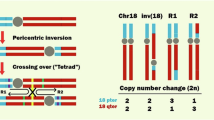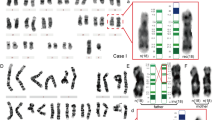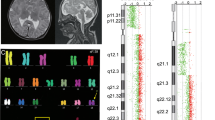Summary
A 7-year-old boy with dysmorphic features was found to have a recombinant chromosome 18, rec(18), resulting from meiotic recombination of a maternal pericentric inversion, inv(18) (p11.2q21.3), as defined by high-resolution banding. He was trisomic for the long arm (q21.3-qter) and monosomic for the short arm (p11.2-pter) of chromosome 18. His clinical features were compared with those in other rec(18) cases, and also those in monosomy 18p, trisomy 18qter and full trisomy 18 syndromes. The risk of recombinant formation for inv(18) carriers was also discussed.
Similar content being viewed by others
Log in or create a free account to read this content
Gain free access to this article, as well as selected content from this journal and more on nature.com
or
References
Andrews, T., Gardiner, A.C. and Boon, A.R. 1982. Recombinant chromosome 18 in two offspring of a chromosome 18 inversion heterozygote.Ann. Génét. 25, 185–188.
Borovik, C.L., Brunoni, D., Sato, A.E., Stavále, J.N., Cardoso, S.H., Montezzo, L.C. and Perez, A.B.A. 1987. Holoprosencephaly as a result of unbalanced familial translocation rep(7;18) (q36;q21).Rev. Brazil. Genet. 10: 269–276.
De Grouchy, J. and Turleau, C. 1977.Clinical Atlas of Human Chromosomes. A Wiley Medical Publication, John Wiley & Sons, New York, Chichester, Brisbane, Toronto, pp. 159–183.
De Torres, L., Ferrer, A.S. and Abrisqueta, J.A. 1984. Partial trisomy 18 due to a maternal translocation t(9;18).Hum. Genet. 68: 272.
Faust, J., Habedank, M. and Nieuwenhuijsen, C. 1976. The 18p-syndrome. Report of four cases.Eur. J. Pediatr. 123: 59–66.
Fryns, J.P., Van Der Hauwaert, L., Dumoulin, M. and Van Den Berghe, H. 1979. New chromosomal syndromes. II. Partial distal 18qter trisomy syndrome.Acta Paediatr. Belg. 32: 217–219.
Fukuhara, K., Fukuhara, K., Mino, M., Kusunoki, T., Misawa, S., Morita, M. and Abe, T. 1979. Partial 18 trisomy syndrome resulting from paternal 6/18 reciprocal translocation.Jpn. J. Human Genet. 24: 13–20.
Hodes, M.E., Cole, J., Palmer, C.G. and Reed, T. 1978. Clinical experience with trisomies 18 and 13.J. med. Genet. 15: 48–60.
Ikeuchi, T. 1984. Inhibitory effect of ethidium bromide on mitotic chromosome condensation and its application to high-resolution chromosome banding.Cytogenet. Cell Genet. 38: 56–61.
ISCN. 1985.An International System for Human Cytogenetic Nomenclature. Harnden, D.G. and Klinger, H.P., eds., Published in collaboration withCytogenet. Cell Genet. (Karger, Basel, (1985).
Korenberg, J.R., Kawashima, H., Pulst, S., Ikeuchi, T., Ogasawara, N., Yamamoto, K., Schonberg, S.A., West, R., Allen, L., Magenis, E., Ikawa, K., Taniguchi, N. and Epstein, C.J. 1990. Molecular definition of a region of chromosome 21 that causes features of the Down syndrome phenotype.Am. J. Hum. Genet. 47: 236–246.
Jacobs, P.A., Melville, M., Ratcliffe, S., Keay, A.J. and Syme, J. 1974. A cytogenetic survey of 11,680 newborn infants.Ann. Hum. Genet., Lond. 37: 359–376.
Kukolich, M.K., Althaus, B.W., Sears, J.W., Mankinen, C.B. and Lewandowski, R.C. 1978. Anormalities resulting from a familial pericentric inversion of chromosome 18.Clin. Genet. 14: 98–104.
Kunze, J., Stephan, E. and Tolksdorf, M. 1972. Ring-Chromosom. 18. Ein 18p-/18q-Deletionssyndrom.Humangenetik 15: 289–318.
Matsuoka, R., Matsuyama, S., Yamamoto, Y., Kuroki, Y. and Matsui, I. 1981. Trisomy 18q. A case report and review of karyotype-phenotype correlations.Hum. Genet. 57: 78–82.
Niazi, M., Coleman, D.V. and Saldaña-Garcia, P. 1978. Partial trisomy 18 in a family with a translation (18;21)(q21;q22).J. Med. Genet. 15: 148–151.
Schinzel, A., Hayashi, K. and Schmid, W. 1976. Further delineation of the clinical picture of trisomy for the distal segment of chromosome 13. Report of three cases.Hum. Genet. 32: 1–12.
Schinzel, A., Schmid, W., Luscher, U., Nater, M., Brook, C. and Steinmann, B. 1974. Structural aberrations of chromosome 18. I. The 18p-syndrome.Archiv. Genet. 47: 1–15.
Schinzel, A. 1984.Catalogue of Unbalanced Chromosome Aberrations in Man. Walter de Gruyter, Berlin, New York, pp. 604–668.
Shinohara, T., Ikeuchi, T., Asano, K., Hashimoto, K., Ueda, Y. and Ogoshi, T. 1985. A case of partial 18q trisomy resulting from a pericentric inversion of maternal chromosome 18.Jpn. J. Human Genet. 30: 160–161.
Steele, M.W., Pan, S., Mickell, J. and Senders, V. 1974. Trisomy for the distal half of the long arm of chromosome No. 18.J. Pediatr. 85: 827–829.
Sutherland, G.R., Gardiner, A.J. and Carter, R.F. 1976. Familial pericentric inversion of chromosome 19, inv(19)(q13q13) with a note on genetic counselling of pericentric inversion carriers.Clin. Genet. 10: 54–59.
Tayel, S.M., Kurczynski, T.W., Casperson, S. and McCorquodale, M.M. 1988. Deletion 9p, duplication 18q in two sisters resulting from a maternal (9;18)(p22;q21.3) translocation.Am. J. Med. Genet. 31: 853–861.
Teyssier, J.R. and Bajolle, F. 1980. Duplication-deficiency of chromosome 18, resulting from recombination of a paternal pericentric inversion, with a note for genetic counselling.Hum. Genet. 53: 195–200.
Turleau, C. and de Grouchy, J. 1977. Trisomy 18qter and trisomy mapping of chromosome 18.Clin. Genet. 12: 361–371.
Vianna-Morgante, A.M., Nozaki, M.J., Ortega, C.C., Coates, V. and Yamamura, Y. 1976. Partial monosomy and partial trisomy 18 in two offspring of carrier of pericentric inversion of chromosome 18.J. Med. Genet. 13: 366–370.
Vigi, V., Maraschio, P., Bosi, G., Guerini, P. and Fraccaro, M. 1977. Risk for recombinants in pericentric inversions of the (p11→q21) region of chromosome 18.Hum. Genet. 37: 1–5.
Wahrman, J., Goitein, R., Richler, C., Goldman, B., Akstein, E. and Chaki, R. 1976. The mongoloid phenotype in man is due to trisomy of the distal pale G-band of chromsome 21. InChromosomes Today, Vol. 5, Johns Wiley & Sons, N.Y., Israel Universities Press, Jerusalem, pp. 241–248.
Wilson, G.N., Heller, K.B., Elterman, R.D. and Schneider, N.R. 1990. Partial trisomy 18 with minimal anomalies: Lack of correspondence between phenotypic manifestations and triplicated loci along chromosome 18.Am. J. Med. Genet. 36: 506–510.
Author information
Authors and Affiliations
Rights and permissions
About this article
Cite this article
Asano, T., Ikeuchi, T., Shinohara, T. et al. Partial 18q trisomy and 18p monosomy resulting from a maternal pericentric inversion, inv(18)(p11.2q21.3). Jap J Human Genet 36, 257–265 (1991). https://doi.org/10.1007/BF01910544
Received:
Accepted:
Published:
Issue date:
DOI: https://doi.org/10.1007/BF01910544
Key Words
This article is cited by
-
The molecular mechanisms of recombinant chromosome 18 with parental pericentric inversions and a review of the literature
Journal of Human Genetics (2023)
-
Pericentric inversion of chromosome 18 in parents leading to a phenotypically normal child with segmental uniparental disomy 18
European Journal of Human Genetics (2011)
-
Familial pericentric inversion of chromosome 18: behavioral abnormalities in patients heterozygous for either the dup(18p)/del(18q) or dup(18q)/del(18p) recombinant chromosome
European Journal of Human Genetics (2005)
-
Partial trisomy 18q
The Indian Journal of Pediatrics (1996)



